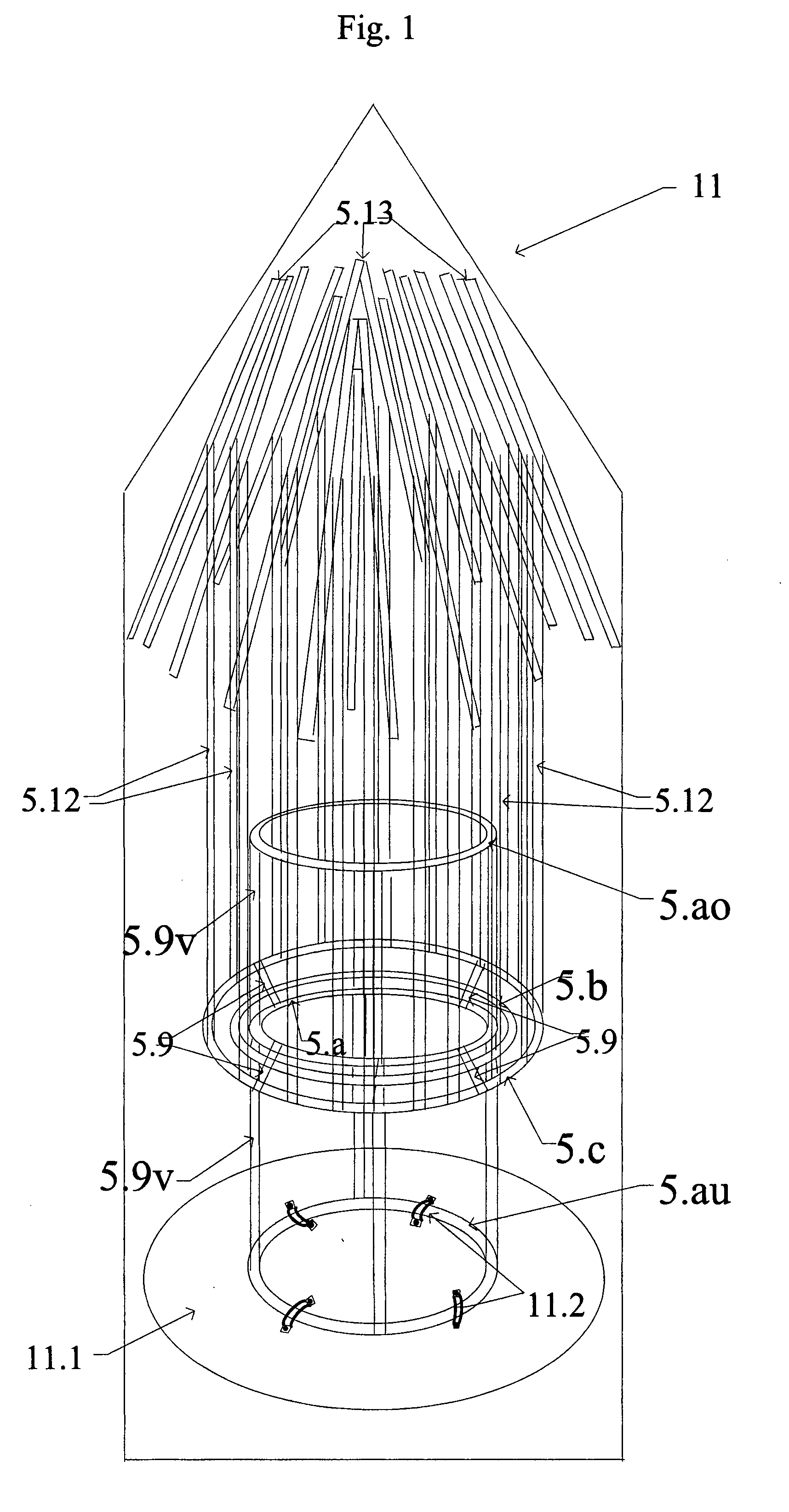In contrast to other solar sail designs, the maneuverability of this solar sail is impaired as little as possible in
spite of extensive handling of
payload masses.
Generally, the daughter units would not carry a solar sail at all, as constant-thrust solar sails would interfere with delicate landing and docking situations.
Also mounting and setting sails on very large solar sails was not adequately simplified nor has an operating concept been drafted.
A further problem was the need that, considering current technical knowledge, a large solar sail could only be space-assembled near a space
station.
Even in the mid-term future, space stations will probably be placed only in
Low Earth Orbit (LEO) which, unfortunately, is also under the influence of atmospheric residues.
In LEO a solar sail craft of huge sailing area would be slowed down so much with its sail set that crashing down to Earth would be extremely difficult to avoid!
Because
robot and astronaut labor in space is extremely limited and costly, out of this circle of experts came the proposal to develop a solar sail based on the previous designs which does not has to be mounted in space.
Such preferred Near-Sun mining missions to asteroids would presumably be orders of magnitude more cost effective than similar missions to the Moon, as those would have to be completed in much higher gravity conditions with a lot less Sun-energy available hence not allowing equipment that is as light and cheap.
Control is further complicated by gravitational forces as those of Earth, which have to be factored in also.
Unwanted torsion forces from shifted force centers arise on other space crafts also and are called “thrust vector misalignment problem”.
Without
counter measures this would lead to a solar sail turning away from the best possible orientation to the Sun.
In the worst case it could neither be steered in a sufficient manner nor driven into the direction desired.
However, vane-steering has it's disadvantages, too.
In abnormal steering situations it could happen that vanes don't work, such as when Sun pressure is parallel to the sail foils of solar sail and of the vanes as well.
On self-deploying square solar sails with self-expanding masts, complications can be expected.
A
disadvantage of steering a solar sail by roller reefing and unfurling is expected fatigue of the thin sail foil material.
This is desirable because steering the solar-sail in Earth
orbit is complicated.
While doing so, the solar sail can only accelerate when it arcs away from the Sun, but not when it arcs toward the Sun.
Additionally there would be conditions were an solar sail ACS could not work, for instance when the solar sail is parallel to the direction of
solar power pressure were no thrust develops.
The inventor assumes, that realizing this
constellation is also easier than the attachment of move able vanes with all of their
engineering mechanics which could lead to stability problems.
The problem however is
material fatigue due to frequently rolling the foil on and off which would damage the sail after some time.
This problem shall be solved for the steering part but unfortunately not for the part of frequent sail setting and reefing.
This method has a drawback as well, which would still be acceptable.
A part of the possible sail area is lost due to the shortened sail foil length.
Because of this the mechanical properties steering / ACS would become over-complicated making it handicapped or nearly impossible.
Though direct construction of a solar sail and even production of parts in space would be certainly optimal (for instance production of sail foils) the current robotic technique has not evolved sufficiently for those tasks or the needed development would be extremely expensive and long-winded.
The reason for this need is, that the
orbit speed of the solar sail (for instance near the ISS) with it's large sail area would get slowed down through atmospheric particles so much that
crash down would be unavoidable.
Another problem of self deflating solar sails is that the sail foils have to be folded before launch and unfolded again when it has reached the place of action.
At first the risk of failure is pretty high for unfolding solar sail foils.
Additionally the sail foils would crease and could get damaged through this.
Out of this reason the sail foils thickness has to be selected accordingly, which leads to an unnecessary
mass enhancement.
However this design of the last application relates to very large space constructed systems with stiff carrying Outer Ring which is assembled from
pipe segments.
This would shorten the duration of the mission substantially.
That saves unnecessary
mass at the solar sail.
In contrast to this, known designs of self unfolding solar sails feature sparse payload volume, no
solar cell arrays and certainly no
docking station for daughter units.
Admittedly those advantages are restricted through the
disadvantage of the self deploying solar sail's much higher mass.
This performance does not look impressive at all, considered, that the self expanding solar sail will show considerably more mass as the mast sail and cannot orientate the sail-thrust as good as SMART I can when using the
ion drives.
The stabilization of direction (for instance for dum-dum bullets) is often desired, on the other hand it would considerably complicate steering as well as
optical observation from a sailcraft which is constantly rotating.
The solar sail in this design is (contrary to the Thruster-Solar-Sail) not able to avoid rotation with the help of thrusters because accordingly directed thrusters don't exist in this case.
In conjunction with a strong launcher, which accelerates to Earth
orbit escape velocity, the poor sailing thrust of the sailcraft is unimportant.
 Login to View More
Login to View More  Login to View More
Login to View More 


